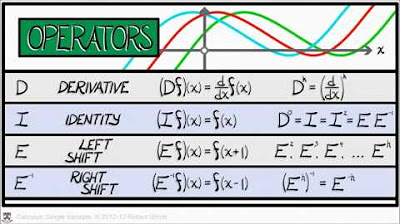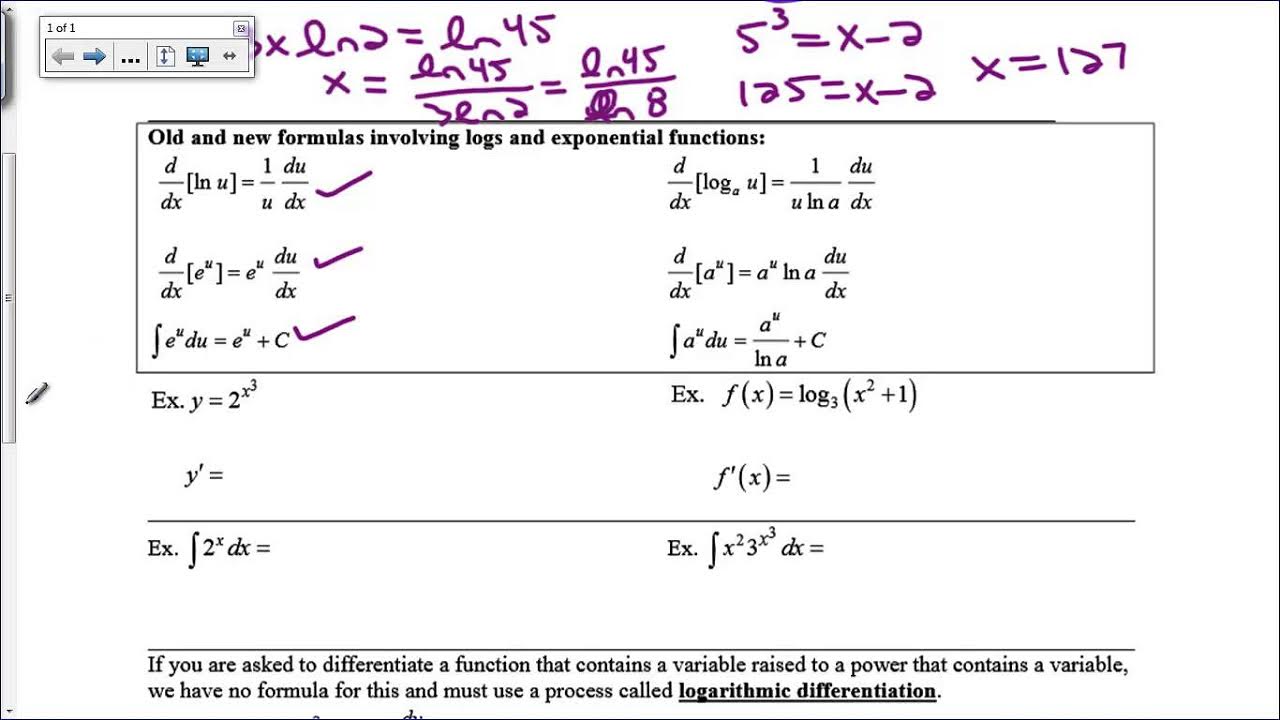Calculus Chapter 2 Lecture 16 d As Operator
TLDRIn this calculus lecture, Professor Gist introduces differentiation as an operator, expanding beyond traditional slope concepts. He demonstrates the power of operators in simplifying complex derivative calculations, such as logarithmic differentiation for functions like e^x and a^x, and the differentiation of logarithms and inverse trigonometric functions. The lecture also tackles challenging limits and the derivative of super-exponential functions, emphasizing the utility of operators in mathematical problem-solving.
Takeaways
- 📚 The lecture introduces differentiation as an operator, broadening the perspective beyond just slopes and numbers.
- 🔍 Derivatives of some functions like 2^x and arcsinh(x) do not follow from basic rules and require a more conceptual approach.
- 🧩 Logarithmic differentiation is a method that uses the natural logarithm operator in conjunction with differentiation to simplify complex functions.
- 📈 The derivative of e^x is computed using logarithmic differentiation, showcasing the process of applying operators to equations.
- 🔑 Understanding the derivative of logarithmic and exponential functions can be reciprocal, aiding in the computation of one another.
- 🤔 The script prompts reflection on the process of differentiation, emphasizing the application of operators and the manipulation of equations.
- 📉 The derivative of log(x) is found by applying exponentiation and differentiation operators, leading to the result 1/x.
- 📚 The concept of using the inverse trigonometric function as an operator is introduced, simplifying the differentiation of functions like arcsin(x).
- 🔄 The versatility of operators is highlighted, showing their utility across various mathematical computations, including limits and derivatives.
- 🌐 An example demonstrates the computation of a limit involving an exponential expression by applying natural logarithms and limits.
- 📈 The derivative of x^x is computed, illustrating how the growth rate of a super-exponential function can be even larger after differentiation.
Q & A
What is the main focus of Professor Gist's lecture 16 on calculus?
-The main focus of the lecture is to introduce differentiation as an operator, which is a more abstract and conceptual approach to understanding derivatives, leading to better comprehension and computational abilities.
Why might a student incorrectly compute the derivative of 2 to the power of x?
-A student might incorrectly compute the derivative as x * 2^(x-1) due to a misunderstanding of the rules of differentiation, which is not the correct derivative of 2^x.
What method is introduced in the lecture to handle complex functions that do not follow basic differentiation rules?
-The lecture introduces logarithmic differentiation as a method to handle complex functions that do not follow basic differentiation rules.
How is the derivative of e to the power of x computed using logarithmic differentiation?
-By setting y as e^x, applying the natural logarithm to both sides, and then differentiating the resulting equation, the derivative of e^x is found to be y, which simplifies to e^x.
What is the derivative of a to the power of x, where 'a' is a constant, according to the lecture?
-The derivative of a^x, where 'a' is a constant, is a * x * log(a), which can be shown through a similar process of logarithmic differentiation.
How can the process of differentiation as an operator help in computing derivatives of functions like log(x) or sin^(-1)(x)?
-By applying the appropriate operators (exponentiation for log(x), and the inverse sine function for sin^(-1)(x)) and then differentiating, one can compute the derivatives of these functions using a method similar to logarithmic differentiation.
What is the derivative of the natural logarithm function log(x), and how is it derived?
-The derivative of log(x) is 1/x. It is derived by setting y as log(x), exponentiating both sides to get e^y = x, differentiating, and then solving for dy/dx.
What is the process to compute the derivative of arcsine (sin^(-1)(x)) as discussed in the lecture?
-By setting y as sin^(-1)(x), applying the sine function to both sides to get sin(y) = x, differentiating, and then solving for dy/dx, the derivative is found to be 1/sqrt(1 - x^2), which is the secant of y.
How can the concept of operators be used to compute limits, as illustrated in the lecture with the limit of (1 + ax)^x as x approaches infinity?
-By defining y as (1 + ax)^x, applying the natural logarithm, taking the limit as x approaches infinity, and then exponentiating the result, the limit is found to be e^a.
What is the derivative of x to the power of x, and how is it computed?
-The derivative of x^x is x^x * (1 + log(x)). It is computed by setting y as x^x, applying the natural logarithm, differentiating, and then solving for dy/dx.
What insight does the lecture provide about the growth rate of derivatives compared to their original functions?
-The lecture suggests that when differentiating functions with super-exponential growth rates, the derivatives can have even larger growth rates, as exemplified by the derivative of x^x being of order O(x^x * log(x)).
Outlines
📚 Introduction to Differentiation as an Operator
Professor Gist introduces the concept of differentiation in calculus, moving beyond the traditional view of derivatives as mere slopes or numerical values. The lecture aims to enhance students' comprehension and computational skills by framing differentiation as an operator. This approach allows for the differentiation of complex functions that do not conform to basic rules, such as 2^x, using logarithmic differentiation. The process involves applying the natural logarithm to an equation and then using the differentiation operator, exemplified by computing the derivative of e^x. The method is also applicable to other functions, including a^x, where 'a' is a constant, and more abstract functions, showcasing the versatility of operators in mathematical computation.
🔍 Exploring Logarithmic Differentiation and Operator Application
This section delves deeper into logarithmic differentiation, illustrating its application to a variety of functions, including exponential and logarithmic forms. The process involves defining a function, applying the natural logarithm, and then using the differentiation operator to find the derivative. The lecture provides a step-by-step example of differentiating e^x and a^x, and extends the concept to other functions like log(x), showing that knowing the derivative of one function can help find the derivative of its inverse. The method is further applied to trigonometric functions, such as arcsine, and their inverses, including hyperbolic functions, demonstrating the power of operator-based approaches in solving complex problems.
🌐 Advanced Operator Techniques in Limits and Derivatives
The final paragraph explores advanced applications of operator techniques in both differentiation and limits. The professor discusses how to compute the limit of (1 + ax)^x as x approaches infinity by applying the natural logarithm and then taking the limit. The use of Taylor expansion simplifies the computation, leading to the conclusion that the limit is e^a. Another example involves finding the derivative of x^x, which is a super-exponential function, by using the natural logarithm to simplify the exponentiation and then differentiating. The resulting derivative is shown to be much larger than the original function, highlighting the impact of differentiation on growth rates. The paragraph concludes with a reflection on the journey from viewing derivatives as slopes to considering them as operators, setting the stage for the next chapter on integration.
Mindmap
Keywords
💡Differentiation
💡Derivative
💡Logarithmic Differentiation
💡Operator
💡Natural Logarithm
💡Exponentiation
💡Limit
💡Taylor Series
💡Asymptotics
💡Product Rule
💡Super-Exponential Growth
Highlights
Introduction to differentiation as an operator rather than just a concept of numbers or slopes.
The differentiation operator allows for better comprehension and computational abilities.
Differentiation of functions like 2^x, which do not follow basic rules, using the operator concept.
Logarithmic differentiation as a method for functions that cannot be differentiated using basic rules.
Derivative of e^x computed via logarithmic differentiation as an example.
The process of applying the natural logarithm operator before differentiation.
Derivative of a^x where 'a' is a constant, using logarithmic differentiation.
The versatility of operators in differentiation, including exponentiation and integration.
Differentiation of logarithmic functions using the exponentiation operator.
Computing the derivative of arcsine using the sine operator and trigonometric manipulation.
Application of operators to compute derivatives of inverse hyperbolic trigonometric functions.
Using operators to compute limits, exemplified by the limit of (1 + ax)^x as x approaches infinity.
The indirect method of applying natural logarithm and taking limits for complex problems.
Derivative of x^x using the natural logarithm to simplify the exponent.
Understanding the growth rates of derivatives and their impact on the size of the resulting functions.
The transition from viewing derivatives as slopes to considering them through various mathematical concepts.
The conclusion of chapter 2 on differentiation and the introduction of integration in chapter 3.
Transcripts
Browse More Related Video

Calculus Chapter 2 Lecture 13 BONUS

Lec 6 | MIT 18.01 Single Variable Calculus, Fall 2007

Logarithmic Differentiation | Example: x^sinx

DERIVATIVES that keep getting HARDER 🤯 | jensenmath.ca

Bases other than e

Derivatives of Exponential Functions & Logarithmic Differentiation Calculus lnx, e^2x, x^x, x^sinx
5.0 / 5 (0 votes)
Thanks for rating: